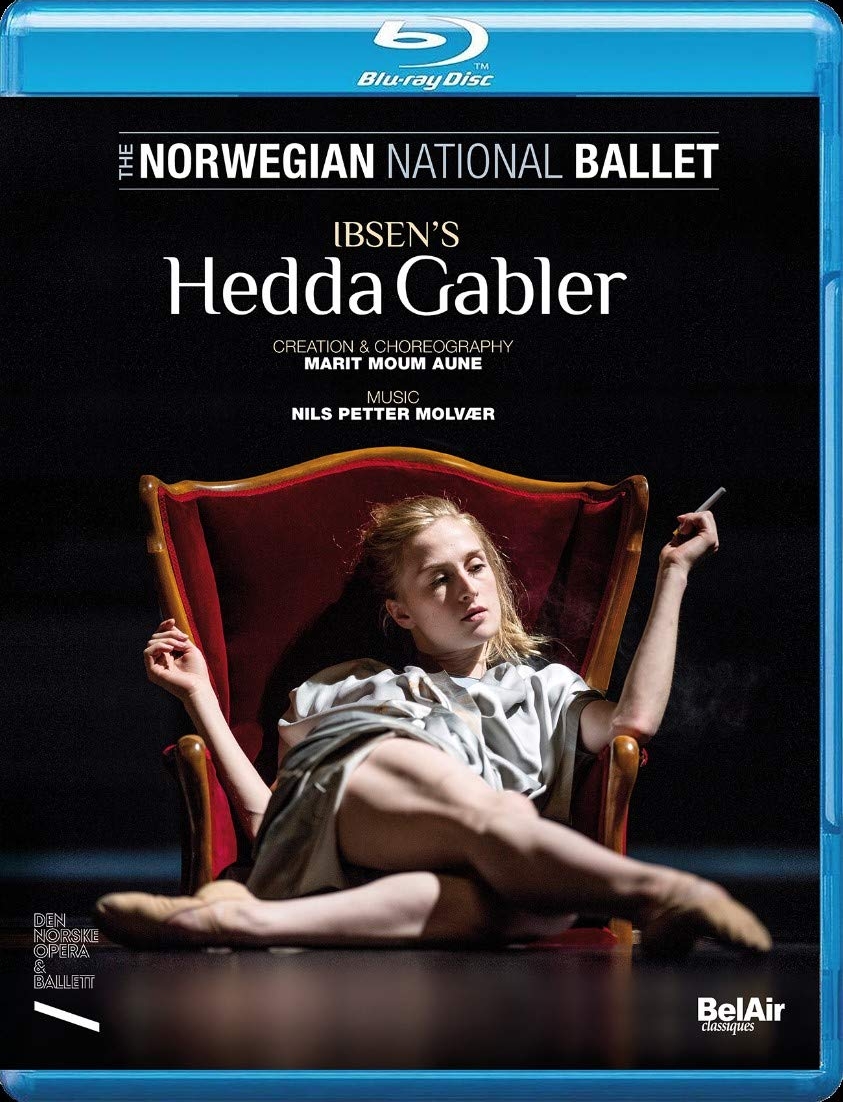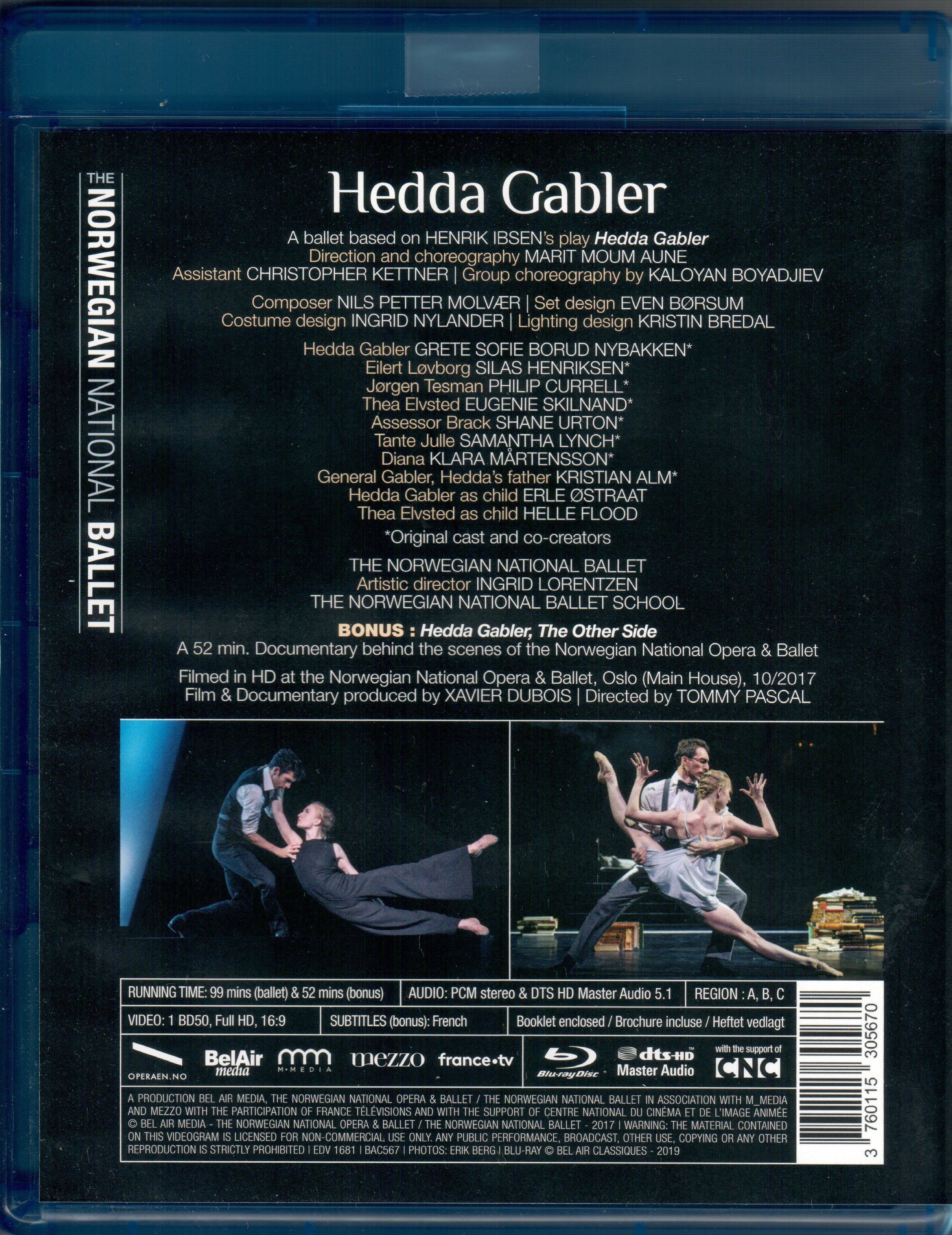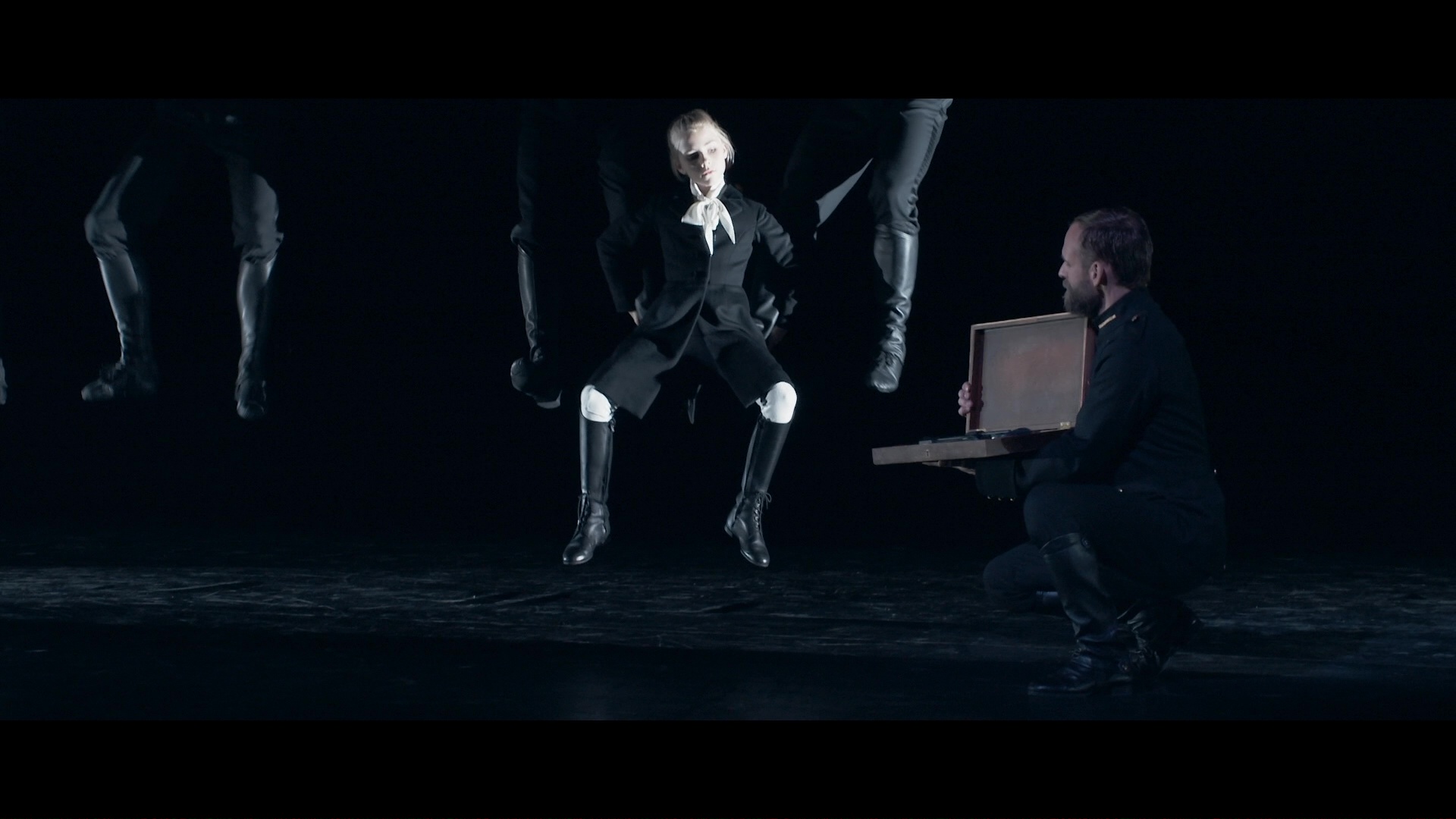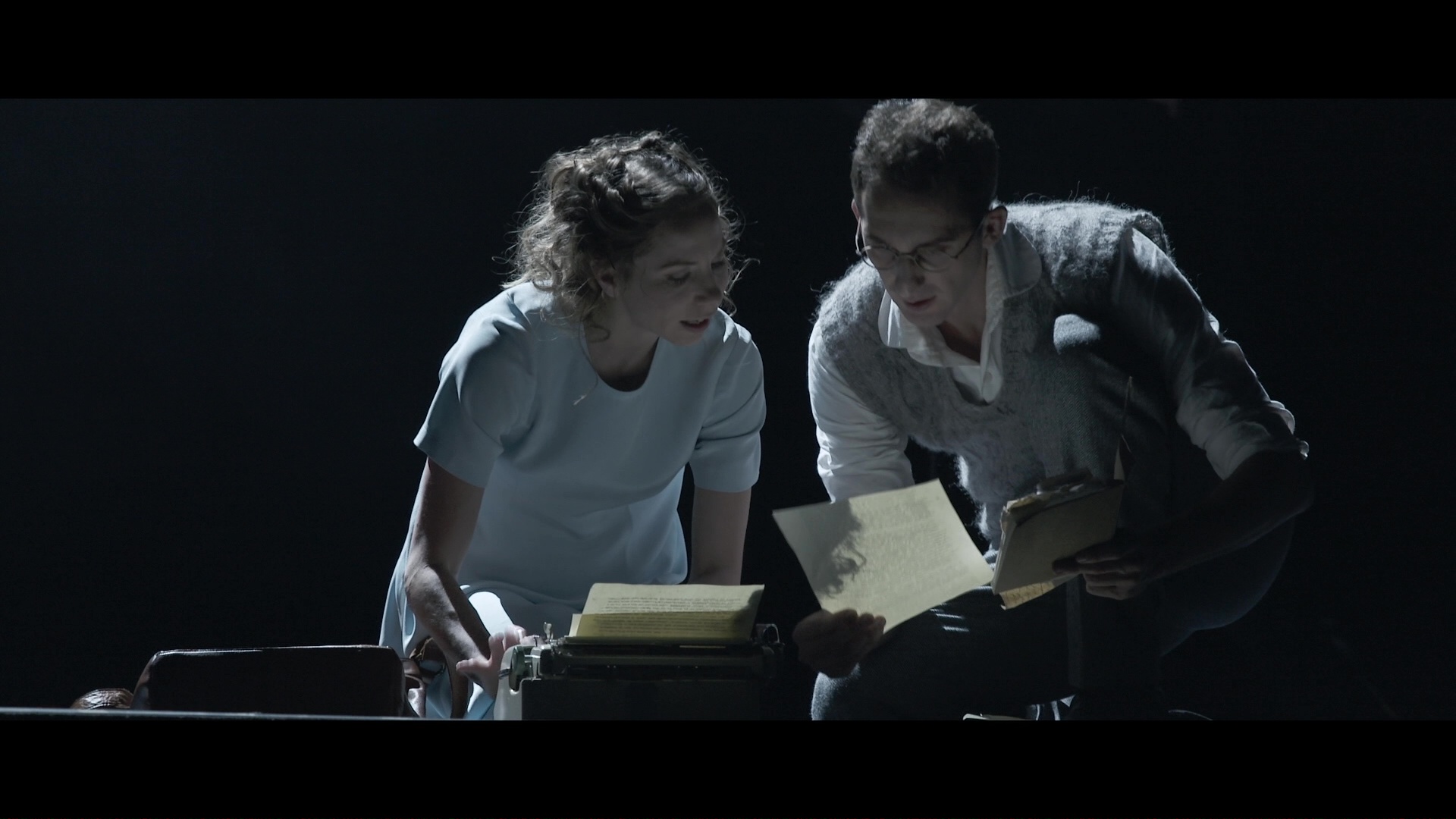

Hedda Gabler ballet. Music composed by Nils Petter Molvær. Choreographed and directed by Marit Moum Aune based on the play of the same name by Henrik Ibsen. Staged 2017 at the Norwegian National Opera and Ballet. Stars Grete Sofie Borud Nybakken (Hedda Gabler) Silas Henriksen (Eilert Løvborg, Hedda’s first lover), Philip Currell (Jørgen Tesman, Hedda’s husband), Eugenie Skilnand (Thea Elvsted, Hedda’s schoolmate), Shane Urton (Assessor or Judge Brack), Samantha Lynch (Aunt Julie), Klara Mårtensson (Diana), Kristian Alm (General Gabler, Hedda’s father), Erle Østraat (Hedda Gabler as child), and Helle Flood (Thea Elvsted as child) supported by other dancers of The Norwegian National Ballet and The Norwegian National Ballet School. Set design by Even Børsum; costume design by Ingrid Nylander; lighting design by Kristin Bredal; assistant direction by Christoper Kettner; group choreography by Kaloyan Boyadjiev. Directed for TV by Tommy Pascal; produced by Xavier Dubois. Released 2019, disc has 5.1 dts-HD Master Audio sound. Grade: B+
Somehow I missed exposure to Ibsen up to now even though he has been the most performed playwright from 1900 on after Shakespeare. I watched this ballet about Hedda Gabler completely cold. I admired the production and dancing, but I was completely baffled as to what was happening. Then I read the play. Ibsen is the father of stage realism: he writes utterly plain language dialog (full of secret double meanings) that gradually reveals complicated preexisting relationships among the protagonists, an intricate plot, and psychology surprises. I don’t know that Ibsen and Freud directly influenced each other; but they lived about the same time and trod the same misty flelds in different ways.
Because it is so hard to follow the plot in this show if watching it cold, I will give you in the screenshots below a basic explanation of the story line. The ballet is only “based on” the play. With my explanations, you should be able to enjoy the ballet quickly. Then if you are really interested, you have to read the play. With the text in mind, you will immediately find many fine points in the ballet production that you missed before. So if you do your homework, the ballet stands up well on repeated viewings.
First below see Hedda as as child (played by Erle Østraat). She’s with her father, General Gabler (Kristian Alm), who has no son and is resigned to teaching his daughter how to ride and shoot straight. He gives her a brace of 2 matching, fine revolvers:
Hedda in her 20s as originated by Grete Sofie Borud Nybakken. She looks exactly as described by Ibsen in print. Born in Norway, she graduated from the school of the Royal Ballet in London. She returned to Oslo, where she has danced a truly impressive number of the leading and supporting roles in today’s ballet repertory. Now she advances the state of the art in dancing and acting in the new role of Hedda with an interpretation that, to my humble knowledge, is unmatched for artistry and intelligence elsewhere in the world today. Based on her comments in the bonus extra, I suspect she could also handle a spoken role in a play or motion picture in English. She may be a disruptive force, and you will probably be hearing more about her in the future. If you have a serious interest in ballet today, you need to watch her Hedda Gabler:
Per Ibsen’s own analysis, Hedda Gabler is a study of the demonic with a female monster named Hedda and her male counterpart, Judge Brack. Hedda’s only positive aspect is her great beauty supported by a clever mind and a keen sense of her superior status in society. This she uses to manipulate all those around her like, well, a general. Next below is a scene of multiple generals and daughters. Both Freud and Salvador Dali would have loved this and other similar images in the show:
Here we see Hedda with her first lover, Løvborg. Hedda spices up her foreplay with a clean shot over her partner’s shoulder. Løvborg is a graduate student at the University. He’s a genius, but also an alcoholic:
I interrupt to show you this art shot of what the body of a modern ballerina really looks like (director Marit Moum Aune is a woman) :
Next below we meet Judge Brack (Shane Urton), a lecher who uses his high office as a tool to target vulnerable women. He and Hedda fall immediately on meeting into the kind of sophisticated flirting only possible between two irresistible forces:
I warned you Ibsen gets complicated. Next below we see in the foreground Hedda as a child tormenting her shy classmate, Thea. On the left, mid-stage, is Thea as an adult. Thea works as secretary and confidant of Løvborg in his efforts to get ahead at the University. Thea is a bit of a nitwit, but she is the only protagonist in this story who earns our sympathy. Deeply in love with Løvborg, she has helped him control his addiction to alcohol.
And finally, in the background is Hedda’s husband, Jørgen (Philip Currell). Jørgen is also a graduate student at the University. He is not, however, a genius or creative. A nitwit like Thea, his main academic interest is the study of household arts and crafts in medieval Brabant. Now how did Jørgen get to marry Hedda? Timing is all. When the General died, his fame and honor were great but his bank account was depleted. Jørgen was from a good family with a expectations of at least a modest inheritance and good prospects for a promotion to Professor at the University. He would be easy for Hedda to dominate and willing to buy Hedda a fine house and take her on a 6-month honeymoon trip all over Europe:
When the show opens, Hedda and Jørgen are back from the lavish wedding trip. Suddenly Løvborg has emerged as a candidate for the Professorship (thereby denying the lucrative post to Jørgen). Thea has been able to keep Løvborg sober while he finishes a wonderful new book. Jørgen pretends to support his old friend Løvborg. But he is in fact terrified that he might not get the job he was counting on after overspending on everything to please Hedda. Meanwhile, Brack works on Hedda, and both are in heat. But Hedda must be careful because her husband may soon be broke. And Hedda knows (but has not announced) that she is pregnant!
Brack throws a “bachelor” party for Jørgen (six months after the wedding)! Hedda cleverly taunts Løvborg into going to the party, which will, of course, be mostly a drinking orgy:
Løvborg gets completed smashed at the party and winds up with Diana (Klara Mårtensson ), an entertainer and prostitute. The following morning, he realizes he lost the precious manuscript during his wild revels!
Løvborg is despondent. Hedda gives him one of Gabler’s pistols with the admonition to use it to do something “beautiful”:
Løvborg doesn’t know that the manuscript he lost was found by Jørgen, who intended to return it to him. But we know demons love fire, and Hedda burns the manuscript. This eliminates the risk that Løvborg might walk away with the Professorship. But the price is, alas, Jørgen’s integrity and honor:
Below behold the death of Løvborg. He suspected that Diana purloined the manuscript, but she convinces him that she doesn’t have it. He puts the pistol in his overcoat and it fires by accident killing Løvborg. His death was Hedda’s goal, but it was not at all beautiful:
Brack sees the fatal pistol at the police station and recognizes it as Hedda’s gun. He figures Hedda must have something to do with the missing manuscript and Løvborg’s death. He offers to hold his tongue in exchange for, h’m, non-financial consideration with regular interest payments. Hedda has lost control!
The two nitwits have both suffered grave losses, but at least they have found each other. Thea kept notes for the manuscript! Now the nitwits are aglow with the realization that they can recreate Løvborg’s book!
Faced with being subservient to demon Brack, Hedda forms a terrible resolve. What do you think she will do with the second pistol?
As pointed out on the blog sanjoyroy.net, Marit Moum Aune is more of a theater director than a choreographer. This you see in the bonus extra as Marit leads the dancers through the text of the play, sketches out the (vastly) simplified plot, and asks the dancers to improvise the dance steps and facial expressions needed to convey the emotions of the protagonists. In the play, the plot is complicated and the rigidly suppressed emotions are only indirectly revealed through patterns of irony built up in the text and fine-scale acting of the speakers. In the ballet, the plot can only be crudely sketched out while the dancers shovel emotions out in extravagant heaps before the audience.
After reading the play, I now think the ballet can hold up to repeated viewings. But what I really want now is an HDVD of a world-class production of the stage play. To date, 10 years after the dawn of the age of HDVD, we have no stage play other than the Shakespeare productions we are getting from The Globe and the RSC!
I did a Wonk Worksheet. Tommy Pascal’s video file has a decent pace of almost 11 seconds per video segment, but only 56% of the segments show the whole bodies of the dancers. I thought I saw many scenes where it would have been easy to shoot and edit longer segments. I also saw a number of segments that were out of focus or poorly framed because the cameramen were working too fast. I will not mark this title down for video content, but I think Pascal missed an opportunity to make a truly eloquent recording. The bonus extra is interesting, but I had trouble understanding many of the speakers (other than Grete) without English subtitles. There was a lot of loud music from the score and many of the speakers had strong accents. The French subtitles provided could be like a Rosetta stone in this situation.
The production and the dancing are interesting throughout. The original music is fine and appropriate for typical modern productions with heavy percussion, electronic instruments, sound effects, and jazz elements.
If you know about Hedda Gabler before you see this, you could easily give this an A. If you focus on Grete’s performance, you would give this an A++. If you are not familiar with the Hedda Gabler story, you might well give this a confused C + grade. For our purposes, I think B+ is about right.
OR

















